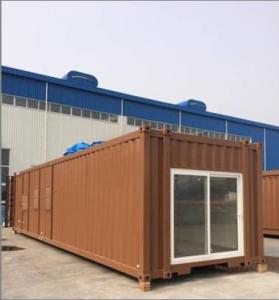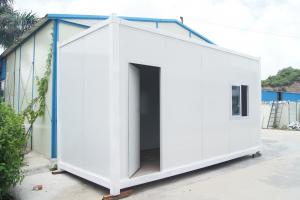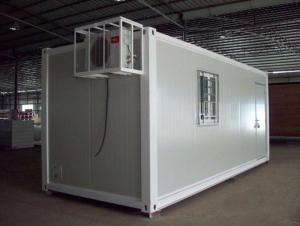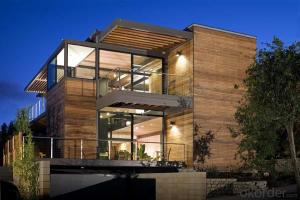Container house for house
- Loading Port:
- China Main Port
- Payment Terms:
- TT OR LC
- Min Order Qty:
- -
- Supply Capability:
- -
OKorder Service Pledge
OKorder Financial Service
You Might Also Like
Our advantages:
1. Qualification: CE(DIN18800), ISO9001, BV
2. Durable, beautiful, economic and environmental
3. High Construction Efficiency (2 worker in one day for one unit)
4. Long life time (Max. 20 years)
5. Easy to transport and assemble (Can load 7 units into one 40'HQ)
Brand Name: PTH
Our advantages:
1) Integrated base and roof, PU injected, excellent strength and tightness
2) 0.426mm color steel sheet for sandwich wall panel, strong and beautiful
3) All electric wires, water pipes, windows, doors and floor pre-setted, easy for assembling
4) Long time oversea project experience
5) 4S sales and service network, buy a house just like to buy a car
| standard | roof load | 0.5KN/sqm (can reinforce the structure as required) |
| Wind speed | designing wind speed: 210km/h (Chinese standard) | |
| seismic resistance | magnitudes 8 | |
| temperature | suitable temperature.-50°C~+50°C |
Usage: The small container house has the following features: light weight, convenient and fast assembling and shipment, many-times disassembling, high rate of reuse. It can be applied to office, command posts, dormitories, meeting rooms, warehouses, shops, additional storey on building roof and temporary houses in the field of building, railways, highways, water conservancy projects, electric power, oil, business, tourism, and military use. And the houses are air-tight, heat-insulating, warm-keeping, waterproof and anti-corrosive.
1. Easy to assemble and disassemble: The houses can be assembled and disassembled for dozens of times and can be reused for many times. And the assembling only needs simple tools and doesn’t need power source. The connections of the pieces of the house all adopt plugs or screw connections.
2. Strong Structure: It adopts steel frame structure, therefore it is stable and in line with the designing code of building structure.
3. Heat-insulation: The roof and wall are made of color steel sandwich panel (EPS, XPS, PU or Rock Wool) which have good heat-insulating and fire-proof performance.
4. Durable: The steel frame parts are all processed with anti-corrosion coating and it can be used as long as 20 years.
5. Environment protection: The design of the house is reasonable and it is easy to assemble and disassemble.
6. Diversified Specifications: Our design can be customized. The doors, windows and front and back walls can be exchanged each other. And the partition walls according to the customers’ requirements.
- Q:Can container houses be designed with a home office space?
- Yes, container houses can definitely be designed with a home office space. The versatility and flexibility of container homes make it possible to create functional and comfortable office spaces within the limited square footage. Proper planning and design considerations can incorporate features such as ample natural light, sufficient storage, ergonomic furniture, and sound insulation to ensure a productive and comfortable work environment.
- Q:Are container houses suitable for Airbnb or vacation rental investments?
- Airbnb or vacation rental investments can greatly benefit from the use of container houses. These innovative structures provide a distinct and trendy lodging experience that appeals to a wide range of guests. The modern and sleek designs of container houses have gained popularity among travelers seeking a unique stay. There are several advantages to investing in container houses for Airbnb or vacation rentals. Firstly, they offer cost-effectiveness as containers can be purchased at a lower price compared to traditional homes. This allows investors to save on initial investment costs and potentially earn higher returns on their investment. Secondly, container houses provide a high level of customization. They can be modified and designed according to the preferences and needs of the target market. This flexibility allows owners to create stylish and one-of-a-kind living spaces, which can be a significant selling point for potential guests. Moreover, container houses are environmentally friendly as they repurpose unused shipping containers and reduce waste. This aspect can be particularly appealing to environmentally conscious travelers who prioritize sustainable accommodation options. In terms of practicality, container houses require relatively less maintenance compared to traditional homes. They are made of durable materials that are resistant to various weather conditions, saving owners both time and money on upkeep and repairs. However, it is important to consider that container houses may not be suitable for all locations or markets. Some areas may have strict regulations or zoning restrictions that limit the potential of container houses as vacation rentals. Prior research and understanding of local regulations is crucial before investing in container houses for Airbnb or vacation rental purposes. In conclusion, container houses are a viable investment option for Airbnb or vacation rentals. Their unique design, cost-effectiveness, customizability, eco-friendliness, and low maintenance requirements make them an attractive choice for both owners and guests. However, it is essential to carefully consider local regulations and market demand before making any investment decisions.
- Q:Are container houses suitable for recreational or sports facilities?
- Recreational or sports facilities can be well-suited for container houses. These structures possess numerous advantages that make them an appealing choice for this purpose. To begin with, container houses are incredibly versatile and easily customizable. They can be modified to meet specific requirements, enabling them to be transformed into gyms, swimming pools, yoga studios, or even sports team clubhouses. In addition, container houses are cost-effective in comparison to traditional construction methods. By utilizing repurposed shipping containers, the cost of materials is significantly reduced, making it a more affordable option. This cost-efficiency allows for more resources to be allocated towards equipment, maintenance, and other crucial aspects of the facility. Moreover, container houses are highly durable and capable of withstanding harsh weather conditions. Their steel structure provides stability and longevity, making them suitable for outdoor recreational or sports facilities. Furthermore, container houses can be easily transported and relocated, providing flexibility in terms of the facility's location. Lastly, container houses contribute to eco-friendliness. Repurposing shipping containers aids in waste reduction and material recycling, aligning with the construction industry's growing focus on sustainability. Although some modifications and customization may be necessary to cater specifically to recreational or sports needs, container houses offer a practical, cost-effective, durable, and eco-friendly solution for creating such facilities. Therefore, they are undoubtedly suitable options for recreational or sports facilities.
- Q:Can container houses be designed with a wrap-around porch?
- Certainly! Container houses have the potential to incorporate a wrap-around porch into their design. The adaptability of container houses permits a variety of design possibilities, including the option to add a wrap-around porch. By strategically positioning container units and constructing openings in the walls, it becomes feasible to seamlessly include a wrap-around porch in the overall architectural plan. The design of this porch can encompass the entirety of the container house or focus on a specific section, depending on the desired layout. The porch serves as an expansion of outdoor living space, elevates the visual allure of the container house, and provides a cozy environment to unwind and appreciate the surroundings.
- Q:Can container houses be designed with a sustainable water system?
- Yes, container houses can be designed with a sustainable water system. There are several ways to achieve this. One option is to install a rainwater harvesting system. This involves collecting rainwater from the roof of the container house and storing it in tanks or cisterns. The collected rainwater can be used for various purposes such as flushing toilets, watering plants, and even for drinking after proper filtration and treatment. This reduces reliance on municipal water supply and conserves water resources. Another sustainable water system for container houses is the use of greywater recycling. Greywater refers to the wastewater generated from sources such as sinks, showers, and washing machines. Instead of letting this water go to waste, it can be treated and reused for non-potable purposes like irrigation, toilet flushing, and cleaning. Greywater recycling systems can be installed in container houses to capture, treat, and store greywater for reuse, reducing the strain on freshwater resources. Additionally, container houses can be designed with efficient plumbing fixtures and appliances that minimize water usage. Low-flow toilets, faucets, and showerheads can significantly reduce water consumption without compromising performance. Energy-efficient dishwashers and washing machines can also help conserve water by using less water per cycle. It is important to note that the design and implementation of a sustainable water system for container houses will depend on various factors such as the location, climate, and individual preferences. Consulting with professionals in the field of sustainable design and water management can help tailor the water system to the specific needs and constraints of the container house.
- Q:Are container houses suitable for military or disaster relief purposes?
- Container houses are a suitable option for military or disaster relief purposes. These houses, created by repurposing shipping containers, have multiple advantages in such situations. To begin with, container houses are extremely durable and can withstand even the harshest weather conditions and earthquakes. This makes them ideal for areas prone to disasters where traditional buildings are easily damaged. Moreover, container houses are portable and can be easily transported to remote or hard-to-reach locations, which is crucial for military operations or disaster relief efforts. They can be quickly set up and used as temporary shelters, field hospitals, or command centers. The standardized size and structure of shipping containers also make them easy to stack and arrange in different ways, allowing for efficient use of space and resources. Furthermore, container houses are cost-effective compared to traditional construction methods. The use of repurposed shipping containers significantly reduces material costs, making them a more affordable housing solution for military or disaster relief organizations with limited budgets. Additionally, container houses can be quickly assembled and disassembled, enabling easy relocation or reuse in different areas, maximizing their long-term value. Lastly, container houses can be customized to meet the specific needs and requirements of military or disaster relief operations. They can be equipped with insulation, ventilation systems, plumbing, and electrical installations, ensuring a comfortable and functional living space for personnel or displaced individuals. In conclusion, container houses are well-suited for military or disaster relief purposes due to their durability, portability, cost-effectiveness, and customization options. They offer a practical and efficient solution for providing temporary housing and infrastructure in challenging environments, supporting the efforts of military personnel and aid organizations during times of crisis.
- Q:What is the cost of container renovation housing?
- if it is luxurious decoration, then about 400-6000 per level, if only the general
- Q:Can container houses be financed like traditional houses?
- Yes, container houses can be financed like traditional houses. Many financial institutions offer mortgage options for container homes, allowing individuals to secure loans and purchase these alternative housing options. However, it is important to note that the process and terms may vary depending on the lender and the specific circumstances.
- Q:How do container houses handle plumbing and sanitation?
- Container houses handle plumbing and sanitation in a similar way to traditional houses, but with a few modifications due to the unique nature of the structure. To begin with, container houses typically have a water supply system that connects to the local water source. This can be achieved by either hooking up to the municipal water supply or by installing a well or rainwater harvesting system. The water supply is then distributed throughout the house using pipes and fixtures just like in a regular home. As for wastewater management, container houses have a sewer system in place. This involves the installation of plumbing pipes to carry wastewater from sinks, showers, and toilets to a septic tank or a municipal sewer line. The plumbing system is carefully designed to ensure proper drainage and prevent any leakage or odors. Additionally, container houses often include a greywater system, which collects and treats wastewater from non-toilet fixtures such as sinks and showers. This treated water can then be reused for irrigation or flushing toilets, reducing water consumption and promoting sustainability. When it comes to sanitation, container houses have bathrooms equipped with standard fixtures, including toilets, sinks, and showers. These fixtures are connected to the plumbing system and operate just like those in a conventional home. It is essential to ensure proper ventilation and waterproofing to prevent any issues related to moisture buildup or mold growth. In summary, container houses handle plumbing and sanitation by connecting to a water supply, featuring a sewer system for wastewater management, and incorporating standard fixtures for hygiene purposes. While there may be some modifications required to fit the unique structure, container houses can offer the same level of functionality and convenience as traditional homes.
- Q:Can container houses be designed with a contemporary or futuristic look?
- Yes, container houses can definitely be designed with a contemporary or futuristic look. With innovative architectural and design techniques, containers can be transformed into sleek, modern structures that blend seamlessly with contemporary aesthetics. By incorporating large windows, minimalist designs, and creative use of materials, container houses can achieve a futuristic look that is both stylish and sustainable.
1. Manufacturer Overview |
|
|---|---|
| Location | |
| Year Established | |
| Annual Output Value | |
| Main Markets | |
| Company Certifications | |
2. Manufacturer Certificates |
|
|---|---|
| a) Certification Name | |
| Range | |
| Reference | |
| Validity Period | |
3. Manufacturer Capability |
|
|---|---|
| a)Trade Capacity | |
| Nearest Port | |
| Export Percentage | |
| No.of Employees in Trade Department | |
| Language Spoken: | |
| b)Factory Information | |
| Factory Size: | |
| No. of Production Lines | |
| Contract Manufacturing | |
| Product Price Range | |
Send your message to us
Container house for house
- Loading Port:
- China Main Port
- Payment Terms:
- TT OR LC
- Min Order Qty:
- -
- Supply Capability:
- -
OKorder Service Pledge
OKorder Financial Service
Similar products
New products
Hot products
Hot Searches
Related keywords

























